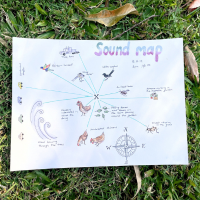4th June 2023
Song
The sounds of nature can help us appreciate the richness and diversity of the natural world, from the songs of birds to the buzzing of insects to the rustling of leaves. Paying attention to the sounds in nature can be a rewarding and enriching experience that can benefit us on many levels, from physical and mental health to environmental awareness and stewardship.
Live event
*You can use a timezone converter to check the workshop time in your area
Nature journaling prompts and ideas
When we think of sounds in nature, birdsong is often the first thing that comes to mind. All birds have unique calls and learning to identify bird calls can be a wonderful way to connect with your nearby nature. When trying to learn birdsong, do not try to learn all the calls at once. Choose one common bird in your area and spend some time listening to its song. How could you use your nature journal to help record and learn the bird calls around you? Once you are familiar with the song of one bird species, you can move onto learning the next one.
There are lots of online resources available to help you learn bird song. Try watching this wonderful video from John Muir Laws. The Bird Academy at Cornell Lab of Ornithology even have an online course you can take to get started birding by ear.
One interesting way to nature journal about the sounds around us is to create a sound map. This activity comes from the book Sharing Nature With Children, by Joseph Cornell. To make a sound map, start by putting an X at the centre of your page, to represent yourself. Then, add all the things you can hear around you to your map. Show the distance of the sounds by locating them close to, or far from, your X. John Muir Laws explains the sound map exercise in this episode of his Nature Journal Connection video series.
Focusing on the sounds in nature can be its own form of mindfulness meditation. Find a comfortable place to sit and direct your attention to the soundscape. Notice each sound as it arises and passes, without judgment or labelling. Just listen. When your attention wanders to thoughts, or to your other senses, gently bring it back to the sounds around you. When you have finished, you could write about the experience in your nature journal. What did you notice? What did you feel?
It is wonderful to listen to the songs of nature, but we can also be active participants in the making of music in, and with, nature. Musician and sound artist Nick Byron Campbell, who creates under the name Left Vessel, makes music in nature using an arbow. An arbow is a temporary instrument made in collaboration with a living tree. You can learn more here.
How could you collaborate with nature to make music? One simple idea is to create some natural percussion using sticks or stones. This is a lot of fun to do in a group!
Nature makes sounds that we cannot hear, without a little help! Canada-based former biologist and sound artist Tarun Nayar uses a different approach to make music that sounds quite unlike anything else. His project Modern Biology makes,“mushroom music”: It’s created by connecting electrodes and modular synthesisers to fungi and measuring their bioelectrical energy, which then triggers note changes in the synthesiser. The result is astounding, and applies to the plant world too. You can listen here.
Each ecosystem has its own unique collection of sounds. The Sounds of Your Park project is collection of recorded soundscapes that celebrate the sonic diversity of the worlds national parks and other protected areas. You can have an immersive sound experience from diverse locations across the globe by visiting the Sounds of Your Park website. You might even decide to submit a recording of the sounds of nature where you live!







